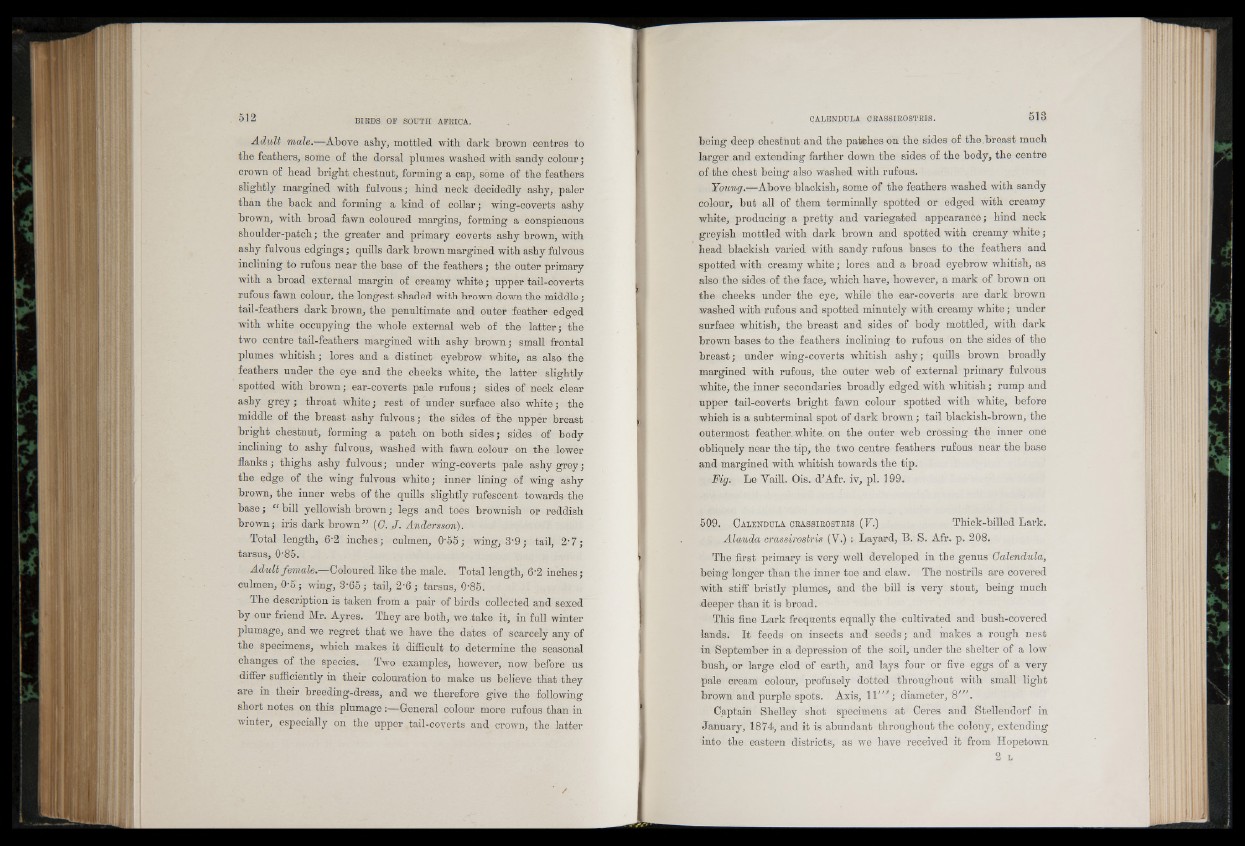
Adult male.—Above ashy, mottled with dark brown centres to
the feathers., some of the dorsal plumes washed with sandy colour;
crown of head bright chestnut, forming a cap, some of the feathers
slightly margined with fulvous; hind neck decidedly ashy, paler
than the back and forming a kind of collar; wing-coverts ashy
brown, with broad fawn coloured margins, forming a conspicuous
shoulder-patch; the greater and primary coverts ashy brown, with
ashy fulvous edgings; quills dark brown margined with ashy fulvous
inclining to rufous near the base of the feathers; the outer primary
with a broad external margin of creamy white; upper tail-coverts
rufous fawn colour, the longest shaded with brown down the middle;
tail-feathers dark brown, the penultimate and outer feather edged
with white occupying the whole external web of the latter; the
two centre tail-feathers margined with ashy brown.; small frontal
plumes whitish; lores and a distinct eyebrow white, as also the
feathers under the eye and the cheeks white, the latter slightly
spotted with brown; ear-coverts pale rufous; sides of neck clear
ashy grey; throat white; rest of under surface also white; the
middle of the breast ashy fulvous; the sides of the upper breast
bright chestnut, forming a patch on both sides; sides of body
inclining to ashy fulvous, washed with fawn colour on the lower
flanks; thighs ashy fulvous; under wing-coverts pale ashy grey;
the edge of the wing fulvous white; inner lining of wing ashy
brown, the inner webs of the quills slightly rufescent towards the
base; “ bill yellowish brown; legs and toes brownish or reddish
brown; iris dark brown” (C. J. Andersson).
Total length, 6'2 inches; culmen, 0'55; wing, 3’9; tail, 2 '7 ;
tarsus, 0-85.
Adult female. Coloured like the male. Total length, 6-2 inches;
culmen, 0’5 ; wing, 3'65; tail, 2‘6; tarsus, 085.
The description is taken from a pair of birds collected and sexed
by our friend Mr. Ayres. They are bothj we .take it, in full winter
plumage, and we regret that we have the dates of scarcely any of
the specimens, which makes it difficult to determine the seasonal
changes of the species. Two examples, however, now before us
differ sufficiently in their colouration to make us believe that they
are in their breeding-dress, and we therefore give the following
short notes on this plumage :—General colour more rufous than in
winter, especially on the upper tail-coverts and crown, the latter
being deep chestnut and the pa1*hes on the sides of the .breast much
larger and extending farther down the sides of the body, the centre
of the chest being also washed with rufous.
Young.—Above blackish, some of the feathers washed with sandy
colour, but all of them terminally spotted or edged with creamy
white, producing a pretty and variegated appearance; hind neck
greyish mottled with dark brown and spotted with creamy white;
head blackish varied with sandy rufous bases to the feathers and
spotted with creamy white; lores and a broad eyebrow whitish, as
also the sides of the face, which have, however, a mark of brown on
the cheeks under the eye, while the ear-coverts are dark brown
washed with rufous and spotted minutely with creamy white; under
surface whitish, the breast and sides of body mottled, with dark
brown bases to the feathers inclining to rufous on the sides of the
breast; under wing-coverts whitish ashy; quills brown broadly
margined with rufous, the outer web of external primary fulvous
white, the inner secondaries broadly edged with whitish; rump and
upper tail-coverts bright fawn colour spotted with white, before
which is a subterminal spot of dark brown; tail blackish-brown, the
outermost feather,.white, on the outer web crossing the inner one
obliquely near the tip, the two centre feathers rufous near the base
and margined with whitish towards the tip.
Fig. Le Vaill. Ois. d’Afr. iv, pi. 199.
509. C alendula crassirostris (F.) Thick-billed Lark.
Alauda crassirostris (V.) : Layard, B. S. Afr. p. 208.
The first primary is very well developed in the genus Calendula,
being longer than the inner toe and claw. The nostrils are covered
with stiff bristly plumes, and the bill is very stout, being much
deeper than it is broad.
This fine Lark frequents equally the cultivated and bush-covered
lands. It feeds on insects and seeds; and makes a rough nest
in September in a depression of the soil, under the shelter of a low
bush, or large clod of earth, and lays four or five eggs of a very
pale cream colour, profusely dotted throughout with small light
brown and purple spots. Axis, 11'"; diameter, 8"'.
Captain Shelley shot specimens at Ceres and Stellendorf in
January, 1874, and it is abundant throughout the colony, extending
into the eastern districts, as we have received it from Hopetown
2 L